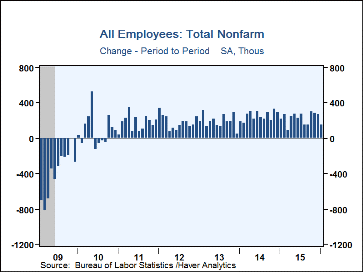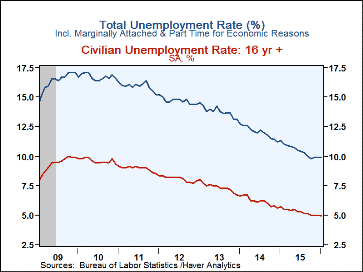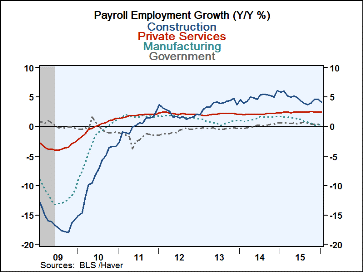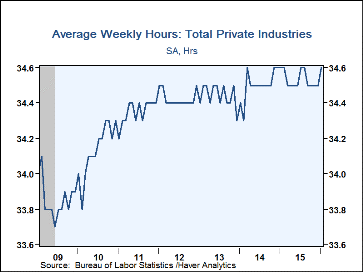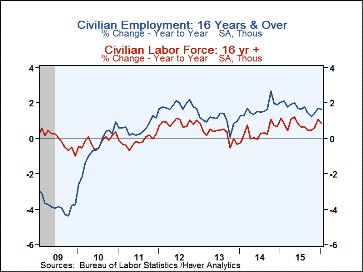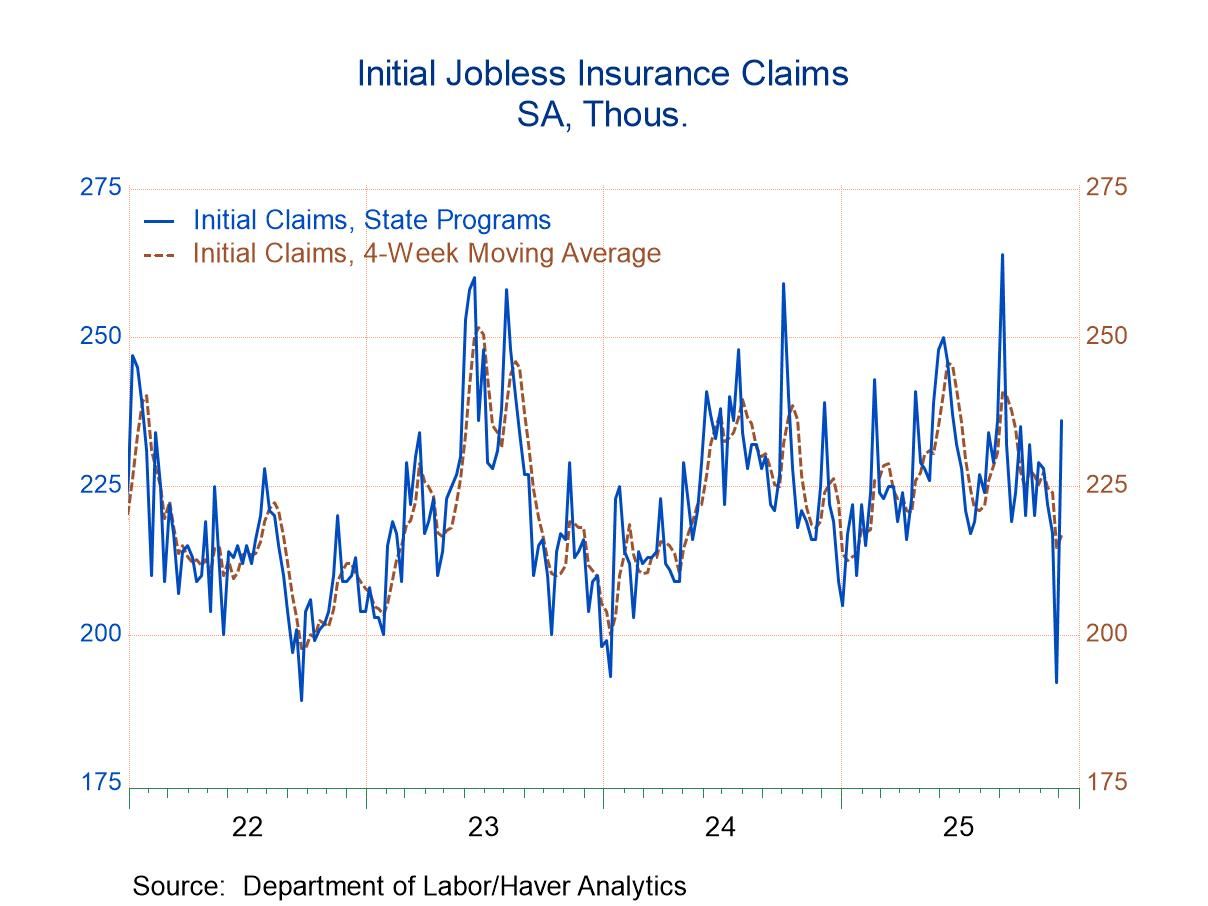 Global| Feb 05 2016
Global| Feb 05 2016U.S. Payrolls Increase Moderately; Unemployment Rate Declines; Earnings Strengthen
by:Tom Moeller
|in:Economy in Brief
Summary
Nonfarm payrolls increased 151,000 during January following gains of 262,000 during December and 280,000 in November. Revisions subtracted a net 2,000 jobs in these two months. Expectations had been for a 198,000 rise in the Action [...]
Nonfarm payrolls increased 151,000 during January following gains of 262,000 during December and 280,000 in November. Revisions subtracted a net 2,000 jobs in these two months. Expectations had been for a 198,000 rise in the Action Economic Forecast Survey. The unemployment rate declined to 4.9%, its lowest level since February 2008. Expectations had been for stability at 5.0%. The overall unemployment rate including marginally-attached workers and those employed part-time for economic reasons held steady at 9.9%. Average hourly earnings jumped 0.5%, exceeding forecasts for a 0.3% rise.
From the payroll employment survey, jobs grew 151,000 last month. Earlier data were revised back to January 2011. Factory sector jobs grew 29,000 (0.4% y/y), the strongest increase since August 2013. Strength in both the fabricated metals and food production industries was notable. Growth in construction jobs eased, however, to 18,000, the weakest rise since September. Mining industry employment fell another 6,600. It's been down in each month since October 2014 for a total decline of 17.1%. Private service-producing industry employment rose 118,000, the weakest gain (by far) since March of last year. Notable weakness occurred in the professional & business services sector which generated just 9,000 jobs, well off the pace of 3.2% growth during the last year. The easing reflected a 25,200 decline (+3.2% y/y) in temporary help-services hiring, fully reversing the prior month's gain. Also falling were transportation & warehousing jobs by 20,300 (+1.5% y/y) and employment in education services which dropped 38,500 (+0.5% y/y). Showing strength were jobs in retail trade which rose 57,700 (2.0% y/y) as they made up a small December decline. Leisure & hospitality employment increased a steady 44,000 (3.1% y/y) and financial activities employment gained 18,000 (1.8% y/y). Wholesale trade hiring gained 8,800 (1.0% y/y) while health care & social assistance jobs rose 3,400 (3.3% y/y).
Weekly hours improved to 34.6 on average, the longest workweek since August. The rise to the cycle's high reflected a jump in service-producing industries to 33.5 hours, up versus the 2009 average of 32.9 hours. Strength in financial activities (37.7 hours), professional & business services (36.3 hours) and education & health services (32.9 hours) also was notable.
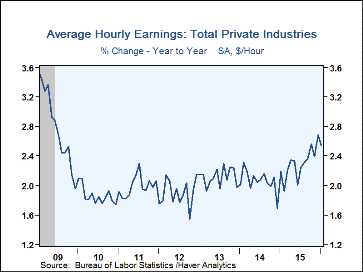 Average hourly earnings in the private sector increased 0.5% following no
change during December. The 2.5% y/y growth rate was improved versus a 1.7% y/y
gain in December 2014. Strength was notable in information (4.3% y/y), financial
activities (3.3% y/y), leisure & hospitality (3.2% y/y) and manufacturing
(2.9% y/y).
Average hourly earnings in the private sector increased 0.5% following no
change during December. The 2.5% y/y growth rate was improved versus a 1.7% y/y
gain in December 2014. Strength was notable in information (4.3% y/y), financial
activities (3.3% y/y), leisure & hospitality (3.2% y/y) and manufacturing
(2.9% y/y).
From the household employment survey, the decline in the unemployment rate to 4.9% reflected a 615,000 rise (1.6% y/y) in employment and a 502,000 increase (0.8% y/y) in the labor force. The unemployment rate was down from its 10.0% peak in October 2009. There has been a rise in recent months in the labor force participation rate to 62.7%, up from a 62.4% low last September. The population grew 461,000 last month (1.1% y/y). The number of potential workers not in the labor force has fallen for four consecutive months.
The unemployment rate for individuals aged 25 and over held m/m at 4.0%. For younger individuals, however, it was 10.3%. For teenagers, the rate was 16.0%, 14.4% for whites and 25.2% for blacks.
Education matters. For individuals without a high school diploma, unemployment of 7.4% compared to 5.3% for high school graduates with no college. For those with some college but no degree, the unemployment rate was 4.2% and for college graduates or higher, it was 2.5%.
The labor market data is contained Haver's USECON database. Detailed figures are in the EMPL and LABOR databases. The expectations figure is in the AS1REPNA database.
Changes in Labor Participation and Household Income from the Federal Reserve Bank of San Francisco is available here.
| Employment: (SA, M/M Change, 000s) | Jan | Dec | Nov | Jan Y/Y | 2015 | 2014 | 2013 |
|---|---|---|---|---|---|---|---|
| Payroll Employment | 151 | 262 | 280 | 1.9% | 2.1% | 1.9% | 1.6% |
| Previous | -- | 292 | 252 | -- | -- | -- | -- |
| Manufacturing | 29 | 13 | 3 | 0.4 | 1.1 | 1.4 | 0.8 |
| Construction | 18 | 48 | 65 | 4.5 | 4.8 | 5.0 | 3.7 |
| Private Service-Producing | 118 | 197 | 226 | 2.4 | 2.5 | 2.1 | 2.1 |
| Government | -7 | 11 | 1 | 0.3 | 0.5 | 0.0 | -0.3 |
| Average Weekly Hours - Private Sector | 34.6 | 34.5 | 34.5 | 34.6 (Jan.'15) |
34.5 | 34.5 | 34.5 |
| Private Sector Average Hourly Earnings (%) | 0.5 | 0.0 | 0.2 | 2.5 | 2.3 | 2.1 | 2.1 |
| Unemployment Rate (%) | 4.9 | 5.0 | 5.0 | 5.7 (Jan.'15) |
5.3 | 6.2 | 7.4 |
Tom Moeller
AuthorMore in Author Profile »Prior to joining Haver Analytics in 2000, Mr. Moeller worked as the Economist at Chancellor Capital Management from 1985 to 1999. There, he developed comprehensive economic forecasts and interpreted economic data for equity and fixed income portfolio managers. Also at Chancellor, Mr. Moeller worked as an equity analyst and was responsible for researching and rating companies in the economically sensitive automobile and housing industries for investment in Chancellor’s equity portfolio. Prior to joining Chancellor, Mr. Moeller was an Economist at Citibank from 1979 to 1984. He also analyzed pricing behavior in the metals industry for the Council on Wage and Price Stability in Washington, D.C. In 1999, Mr. Moeller received the award for most accurate forecast from the Forecasters' Club of New York. From 1990 to 1992 he was President of the New York Association for Business Economists. Mr. Moeller earned an M.B.A. in Finance from Fordham University, where he graduated in 1987. He holds a Bachelor of Arts in Economics from George Washington University.


